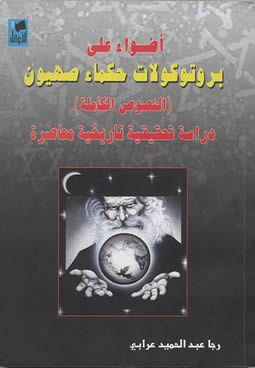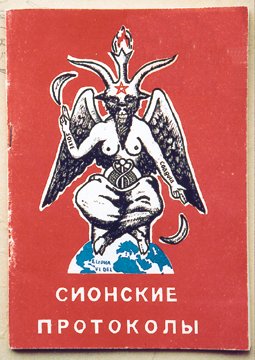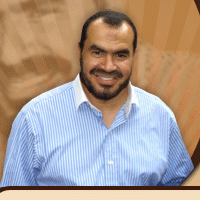![]()
Fri, April 30, 2010 | Edited by Crethi Plethi

This English translation (by Victor E. Marsden) of the "Protocols" uses the classic anti-Semitic image of the Jew as a snake encircling the globe. London, 1978
What Are “The Protocols of The Learned Elders of Zion”?
The Protocols of the (Learned) Elders of Zion (Russian: “Протоколы сионских мудрецов” or “Сионские протоколы”) is one of many titles given to an antisemitic text purporting to describe a plan to achieve global domination by the Jewish people. Following its first public publication in 1903 in the Russian Empire, a series of articles printed in The Times in 1921 revealed that much of the material was directly plagiarized from earlier works of political satire unrelated to Jews. (source: wikipedia).
You can download a copy of “The Protocols of the (Learned) Elders of Zion” (for educational purposes only), here.
The following essay is published at the holocaust-history.org website.
The war that the Nazis waged against the Jews was not just a war of physical annihilation. It was an international war of propaganda to convince the rest of the world of the evils of Judaism. One of the primary weapons that the Third Reich used for this international effort was a forgery known as “The Protocols of the Elders of Zion.” It is claimed that the Protocols are the minutes of a meeting of Jewish leaders at the first Zionist Congress in Basel, Switzerland, in 1897, in which Jews plotted to take over the world. The Protocols are a complete forgery most of which was copied from an obscure satire on Napoleon III by Maurice Joly called “Dialogue aux Enfers entre Montesquieu et Machiavel” (“A Dialogue in Hell Between Montesquieu and Machiavelli”).
The story of the Protocols starts with a chapter in a novel called “Biarritz” by a German bureaucrat named Hermann Goedesche writing under the pseudonym “Sir John Retcliffe” (sometimes altered to “Sir John Readcliffe” in later literature). Goedesche was an anti-Semite in the middle of the 19th century who believed in a conspiracy between Jews and Masons to dominate the world. One chapter of the novel, titled “In the Jewish Cemetery in Prague” relates a speech by a Rabbi named Eichhorn or Reichhorn which reveals a Jewish plot against European civilization. Although it was part of a novel, it was printed separately as an anti-Semitic pamphlet in Russia as early as 1872. It was widely circulated as a truthful account for the rest of the 19th century and represents the precursor of the Protocols. It is still occasionally attached to current editions of the Protocols.
The Protocols were actually written in Paris sometime between 1895 and 1899 by an agent of the Russian secret police Pytor Ivanovich Rachovsky, who is known to have forged other documents for the various intrigues in which he took part. While the Protocols are overtly anti-Semitic it is believed that the Russian minister of finance, Sergei Witte, was also a target of the Protocols. At the time Witte was the leader of the movement to modernize Russia and limit the influence of the old Russian aristocracy. The Protocols attempt to discredit Witte’s reforms of the Russian economy by linking Witte’s program to a Jewish plot to destroy western civilization.
The Protocols, as they are usually published, are divided into twenty-six separate chapters each of which are a lecture on how to subvert western civilization, although some versions, including the first in Englsh, did not have this division. The “program” set forth in the Protocols is vague and generalized. The Protocols advise, for example: “Therefore in governing the world the best results are obtained by violence and intimidation, and not by academic discussions.” (Protocol 1). Some are just silly. One Protocol (23) advocates making people unhappy by passing laws prohibiting drunkenness. The Protocols are vigorously anti-democratic as well. Protocol 25 advises: “Several members of the seed of David will prepare Kings and their successors, who will be elected not by right of inheritance but by their own capabilities. These successors will be initiated in our secret political mysteries and plans of governing, taking great care that no one else should acquire them.”
The parochial political controversies that sparked the writing of the Protocols was soon forgotten but the anti-Semitism remained. The Protocols were first published in full by Sergei Nilus, another agent of the Russian secret police, in 1905. Nilus, who might have been one of the authors of the Protocols, became their main promoter; he circulated several editions of the Protocols in Russia as part of an campaign of anti-Semitism. While the early publications of the Protocols were in Russia, it was spread to the rest of Europe by Russian expatriates after the fall of the Tsars in 1917, where they claimed that it provided proof that the Jews were behind the Russian Revolution. Another expatriate Russian, Boris Brasol, brought it to the United States around 1920 where it became the core of Henry Ford’s anti-Semitic program. By the time Nilus died in 1930, Europe had been saturated by millions of copies of the Protocols. It had also been exposed as a forgery.
The Protocols reached Germany sometime around 1918. One of those who brought them to Germany was Alfred Rosenberg, an (Jewish) Estonian of German heritage who first encountered the Protocols when a student in Moscow. According to Rosenberg a stranger entered his room, placed the book on the table and silently departed. Whether his tale was true or not, Rosenberg soon became an anti-Semite convinced of the authenticity of the Protocols. When he fled Raval (now Talinn) in the civil war that followed the Russian Revolution, he took the Protocols with him.
In Germany Rosenberg soon became involved with a mystical group that was a precursor to National Socialism known as the Thule Society where he frequently lectured about the Protocols. Rosenberg was there to explain the mysteries of the Protocols when Adolf Hitler appeared on the stage of right-wing politics in 1921. Rosenberg was at Hitler’s side during the attempted putsch in Munich in 1923. By then the Protocols had become one of the central themes of Nazi thought. The Protocols were the basis for much of Mein Kampf, and Rosenberg’s book The Myth of the 20th Century became the most important exposition of Nazi philosophy.
It was already known that the Protocols were a forgery when Hitler received his first copy. The exposure of the forgery began as soon as the Protocols began to appear in western Europe but the coup de grâce occurred in 1921, one year after the Protocols were first published in Great Britain. In August, 1921, the Times of London printed a devastating exposure of the forgery by printing extracts from the Protocols side-by-side with the passages from Joly’s book that had been plagiarized. From that point, the Protocols were dismissed by thinking people everywhere. It did not, however, stop the wide circulation of the Protocols by Russian expatriates and later by Hitler. Even the decision by a Swiss court after consultation with three experts (one appointed by the publisher) in May, 1935 did not affect the distribution of the Protocols by the Third Reich.
The anti-Semitic agitation of the Nazis was international in scope. The Protocols was the chief weapons used in the propaganda campaign against the Jews. Under the direction of Joseph Goebbels, the Protocols were translated into many other languages and the world was flooded with cheap editions of the forged document. With Henry Ford’s “The International Jew” (also based in large part on the Protocols), it became the staple text for the anti-Semitism exported by the Nazis around the world. In Mein Kampf, Hitler described the importance of the Protocols to his program of anti-Semitism:
… To what extent the whole existence of this people is based on a continuous lie is shown incomparably by the Protocols of the Wise Men of Zion, so infinitely hated by the Jews. They are based on a forgery, the Frankfurter Zeitung moans and screams once every week: the best proof that they are authentic. What many Jews may do unconsciously is here consciously exposed. And that is what matters. It is completely indifferent from what Jewish brain these disclosures originate; the important thing is that with positively terrifying certainty they reveal the nature and activity of the Jewish people and expose their inner contexts as well as their ultimate final aims. The best criticism applied to them, however, is reality. Anyone who examines the historical development of the last hundred years from the standpoint of this book will at once understand the screaming of the Jewish press. For once this book has become the common property of a people, the Jewish menace may be considered as broken.
Hitler, Adolf. Mein Kampf (München: Zentralverlag der N.S.D.A.P. Franz Eher Nachf., G.M.B.H., 1935). Volume 1; Chapter XI: Nation and Race (pp. 307-308; Mannheim translation).
Wie sehr das ganze Dasein dieses Volkes auf einer fortlaufenden Lüge beruht, wird in unvergleichlicher Art in den von den Juden so unendlich gehaßten “Protokollen der Weisen von Zion” gezeigt. Sie sollen auf einer Fälschung beruhen, stöhnt immer wieder die “Frankfurter Zeitung” in die Welt hinaus: der beste Beweis dafür, daß sie echt sind. Was viele Juden unbewußt tun mögen, ist hier bewußt klargelegt. Darauf aber kommt es an. Es ist ganz gleich, aus wessen Judenkopf diese Enthüllungen stammen, maßgebend aber ist, daß sie mit geradezu grauenerregender Sicherheit das Wesen und die Tätigkeit des Judenvolkes aufdecken und in ihren inneren Zusammenhängen sowie den letzten Schlußzielen darlegen. Die beste Kritik an ihnen jedoch bildet die Wirklichkeit. Wer die geschichtliche Entwicklung der letzten hundert Jahre von den Gesichtspunkten dieses Buches aus überprüft, dem wird auch das Geschrei der jüdischen Presse sofort verständlich werden. Denn wenn dieses Buch erst einmal Gemeingut eines Volkes geworden sein wird, darf die jüdische Gefahr auch schon als gebrochen gelten.
Aus Mein Kampf: Die Protokolle der Weisen von Zion. Aus 11. Kapitel: Volk und Rasse – Erster Band: Eine Abrechnung.
Even today the Protocols of the Elders of Zion is one of the principal propaganda weapons of anti-Semitism. In the United States it continues to be circulated by the Christian Identity movement, the Ku Klux Klan and neo-Nazi groups. It is still distributed by those who deny the Holocaust as well. The Institute for Historical Review – the intellectual center of the movement denying the Holocaust – continues to sell the Protocols and it is still used to attack Jews. Ernst Zündel, who states openly that he is an admirer of Hitler and claims the Holocaust never happened, still repeats the lies of the Protocols:
“Could it be that word is out that, according to the Protocols of the Wise Elders of Zion, the New World Order is soon going to be locked in place, with Israel the hub of power and the United States its dedicated slave?”
Nor is the United States the only country and English the only language where the Protocols are still being distributed as fact. The Protocols are available in virtually every European country. Translated into Arabic, the Protocols have become a standard text for anti-Semitism in the Middle East. Translated into Japanese, millions of the copies of the Protocols are still being distributed around the Pacific Rim.
“The Protocols of the Elders of Zion” has become a lie that will not die, no matter how often it is exposed as a forgery.

This 2005 Syrian edition includes an "historical and contemporary investigative study" that repeats the blood libel among other anti-Semitic accusations, and argues that the Torah and Talmud encourage Jews "to commit treason and to conspire, dominate, be arrogant and exploit other countries." The first edition of The Protocols of the Elders of Zion (2005), written by Raja ‘Abd al-Hamid ‘Urabi and published by Al-Awael.
Where to start your research.
Norman Cohn, “Warrant for Genocide” Serif Press (1967, 1996) is the most complete history of the Protocols.
Albert Lee, “Henry Ford and the Jews” Stein & Day (1980) explains how they were used by Henry Ford and distributed throughout the world.
Michael Barkan, “Religion and the Racist Right” University of North Carolina Press (Revised Edition; 1997) explains how the Protocols influenced the Christian Identity movement.
D. Sklar, “The Nazis and the Occult” Dorset Press (1977, 1989) explains the connection between the Thule Society and Nazi thought.
More articles about “The Protocols” can be read at: igc.org.



 RSS
RSS













What are The Protocols of the Learned Elders of Zion? #nazism #islamofascism #israel #jcot #antisemitism http://j.mp/caQuZ9
RT @CrethiPlethi: What are The Protocols of the Learned Elders of Zion? #nazism #islamofascism #israel #jcot #antisemitism http://j.mp/caQuZ9
[…] This post was mentioned on Twitter by Elisabeth, Crethi Plethi. Crethi Plethi said: What are The Protocols of the Learned Elders of Zion? #nazism #islamofascism #israel #jcot #antisemitism http://j.mp/caQuZ9 […]
[…] forged document was published in a newspaper owned by Black Hundredist Pavel Krushevan known as the Protocols of the Learned Elders of Zion. Oddly enough, it was published in sets, not unlike many of the conspiracy “threads” […]
[…] is a curious organisation with a curious name. It is redolent of that infamous anti-Semitic forgery “The Protocols of the Elders of Zion”, which was one justification for the Holocaust, and now thought as historic fact in some Arab […]
What Are “The Protocols of The Learned Elders of Zion”? | Middle East, Israel, Arab World, Southwest http://t.co/X6xtbVn2